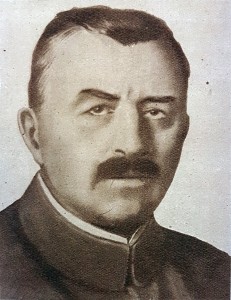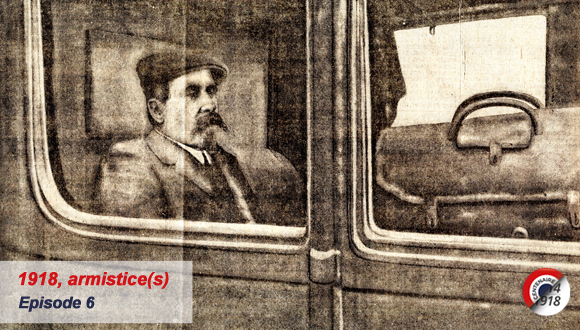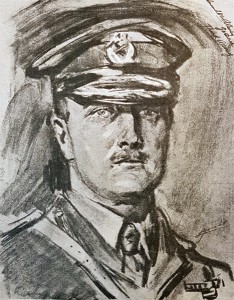 |
Cover of French newspaper Excelsior 14 October 1918. The retouched photograph shows Andrei Liaptchev, the Minister of Finance of the Kingdom of Bulgaria, looking sullen as he travelled by car to General Franchet d’Esperey’s home on Sunday 29 September. Emphasis is placed on a huge schoolbag sitting in front of him, while below, on the doorframe, a detail of the kingdom’s crown can be seen. The same evening, Liaptchev signed the armistice in Thessaloniki with the other two Bulgarian delegates, General Lukov, commander of the 2nd army and Simeon Radev, former minister in Berne. On the right, King Ferdinand of Bulgaria. © Paris, musée de l’Armée.
 General Franchet of Esperey, often referred to as “the victor of Macedonia”. His French Marshal’s staff is on display in the rooms of the Musée de l’Armée. © Paris, musée de l’Armée.
General Franchet of Esperey, often referred to as “the victor of Macedonia”. His French Marshal’s staff is on display in the rooms of the Musée de l’Armée. © Paris, musée de l’Armée.
Portrait Allenby General by Lucien Jonas © Paris, musée de l’Armée.
Armistices before 1 November 1918
Salonique, September 1918
In September 1918, the Allied armies were victorious in a major offensive launched on the Eastern Front against Bulgaria, which was forced to surrender. On September 24, the Kingdom of Bulgaria, which signed an alliance treaty with the Central Powers (6 September 1915), sought a ceasefire from the Allies. The armistice agreement was signed on 29 September 1918 in Thessaloniki, Greece. The treaty’s signatories were French General Louis Franchet of Esperey, who represented the Allies (in connection with Clemenceau), and a Bulgarian commission composed of General Ivan Lukov, Minister Andrei Liaptchev, and Diplomat Simeon Radev. It resulted in the withdrawal from Sofia and provided for the demobilisation and disarmament of the Bulgarian forces. This was the end of the conflict on the Eastern Front.
Moudros, October 1918
In mid-September 1918, British General Allenby launched an offensive in Palestine and occupied the Arab countries. The Ottoman army was then pushed to Aleppo. In October, the Bulgarian defection led to the resignation of the government of the «Youth Turks». The new government immediately entered negotiations with Britain. On 31 October, he signed a convention on board an English battleship, in the port of Moudros, on the island of Lemnos. The Ottoman Empire is represented by its Marine Minister, Rauf Orbay, and its Under Secretary of State for Foreign Affairs, Resat Hikmet Bey, the Allies by British Admiral Arthur Gough-Calthorpe. The Ottomans relinquished their Empire. The armistice was signed then ratified by France, which was not invited to participate in the negotiations.
On 13 November 1918, an Allied fleet made up of 54 English, French and Italian vessels, and a Greek battleship, solemnly entered the Bosphorus and laid anchor in front of Dolmabahçe Palace, where the Sultan Mehmet VI resided. The Allied occupation of Constantinople had begun (1918-1923). Following on the armistice, the Treaty of Sèvres (1920) placed the former Arab provinces of the Empire under British and French mandates and provided for the establishment, in the provinces of Eastern Anatolia, of a large independent Armenia and an autonomous Kurdistan. The Allies, whose objectives had become divergent or even conflicting, are fraying at a unified national resistance led by Mustafa Kemal Atatürk, which took over the whole of Anatolia and regained Constantinople (Lausanne Treaty, 1923).



Ajouter un commentaire